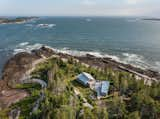A Remote Island Home Accessible Only by Boat Is Immersed Into the Rugged Maine Coast
Partner Story

Along the southern coast of Maine, Harbor Island is a rugged juncture of forest and sea. Blanketed with trees, the remote and largely undeveloped island overlooks alluring views of the bay and open water beyond. However, the unspoiled natural beauty comes at a cost: The isolated location is accessible only by boat—with each residential parcel needing its own dock, as there are no on-island roads. Also, because of the site’s craggy outcrop, it bears the full brunt of storms barreling up the coast, with gale-force winds and potential flooding both quietly looming threats.
Respecting the wildness of the remote location, an adventurous and privacy-seeking couple found a fit in Harbor Island after searching for land for several years. The couple, now with two grown children, engaged Portland, Maine-based Woodhull to design a home for them in the secluded setting. "They love being outdoors," says David Morris, architect and director of Woodhull’s Residential Studio. "They are very resourceful and adventurous and relish in the privacy that this little island provides them."
In designing a home for the secluded site, Morris kept the form simple and unassuming—embracing contrast with the wildness of the surroundings. The home’s siting follows a radial geometry to take advantage of panoramic views. "The building geometry mimics the striated formations of the craggy ledge that was formed when the last glacial maximum retreated around 20,000 years ago," says Morris. From the lower tip of Harbor Island where the home is sited, panoramic views stretch out to the islands in Casco Bay, and back to the mainland on two sides.
A large central deck is the connective tissue of the home’s design. A communal entry point leads to the expansive deck, where the home then branches out in two opposing directions, leading to the main residence and the smaller guest house. "[The deck] is an integral part of the circulation and experience," shares Morris. "This is not a deck at the rear of the house; it is literally the center of the arrangement, and you must use it to use these buildings."
The desire to maximize light and views was tempered by the need for the home to withstand unforgiving storms and natural weather events. "The challenge came in maintaining beautiful views, and access to light and air through large expanses of glass," says Morris. "This desire to keep the elements out while keeping the eyes looking outward was a dance."
The home is clad in unfinished eastern white cedar sourced from Maine, which will darken and silver over time. "Because of the weather, this will not necessarily be consistent, as some areas will see more rain or more sun than others," says Morris. "We feel that over time, this will soften the house even further into the landscape."
Because of the unique setting and climate, special consideration was given to the home’s design and structural integrity. Propped up on piers, the home allows for water to flow underneath it in the improbable—but not impossible—event that a catastrophic "500-year" storm floods the island. When it came to designing the home’s windows, Morris found himself navigating a delicate line. "We obviously wanted to take advantage of the incredible views the site offers, but we also know that windows and openings are weak points in the structure." To account for this challenge while still keeping openings as large as possible, the Woodhull team reinforced mulls between windows with larger structural members to help resist lateral and twisting loads brought on by gale-force winds.
Both the main house and guest house consist of two bedrooms and two bathrooms. Inside, warm and neutral tones keep the focus on the surroundings. "The interior was kept fairly simple," says Morris. "The goal was to keep eyes viewing toward the outside." The solar-powered main house is all-electric, while the uninsulated guest house is reserved for seasonal use.
The Woodhull team created a small nook for the home’s wood-burning stove. "Because we wanted the eyes to continually look outward, we didn’t want the wood stove and associated flue to detract from that," says Morris. "Having it sit inside this nook allows it to still be visible from the living room, but also provides a nice place to sit beside and read."
Between the two structures, the deck becomes an expanded living and dining area shared by both homes. "The placement and organization of the buildings were the most foundational and informative aspects of the project," shares Morris. "The organization and placement of the open deck fosters a sense of gathering between people, and allows those people to feel very connected to the land on which the building shares."
Learn more about all the 2023 honorees and the judging process at andersenawards.dwell.com.
Published
Get the Pro Newsletter
What’s new in the design world? Stay up to date with our essential dispatches for design professionals.











